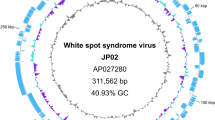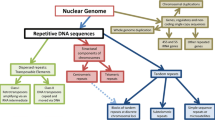Abstract
THE mariner transposable element is a small member of the short inverted terminal repeat class thought to transpose through a DNA intermediate1. Originally described in Drosophila mauritiana2, it is now known in several species of the family Drosophilidae3,4, and in a moth Hyalophora cecropia5. Here I use primers designed to represent regions of amino-acid conservation between the putative transposase genes of the D. mauritiana and H. cecropia elements to amplify equivalent regions of presumed mariner elements from ten other insects representing six additional orders, including the malaria-vector mosquito, Anopheles gambiae. Sequences of multiple clones from each species reveal a diverse array of mariner elements, with multiple subfamilies in the genomes of some insects, indicating both vertical inheritance and horizontal transfers. An intact open reading frame in at least one clone from each species suggests each may carry functional transposable elements. Therefore the mariner element is an excellent candidate for development of genetic transformation systems for non-drosophilid insects, and possibly other arthropods.
Similar content being viewed by others
References
Hartl, D. L. in Mobile DNA (eds Berg, D. E. & Howe, M. M.) 5531–5536 (Am. Soc. Microbiol., Washington DC, 1989).
Jacobson, J. W., Medhora, M. M. & Hartl, D. L. Proc. natn. Acad. Sci. U.S.A. 83, 8684–8688 (1986).
Maruyama, K. & Hartl, D. L. Genetics 128, 319–329 (1991).
Maruyama, K. & Hartl, D. L. J. molec. Evol. 33, 514–524 (1991).
Lidholm, D.-A., Gudmundsson, G. H. & Boman, H. G. J. biol. Chem. 266, 11518–11521 (1991).
Pearson, W. R. & Lipman, D. J. Proc. natn. Acad. Sci. U.S.A. 85, 2444–2448 (1988).
Swofford, D. I. PALP: Phylogenetic Analysis Using Parsimony, Version 3 (Illinois Natural History Survey, Champaign, Illinois, 1991).
Medhora, M., Maruyama, K. & Hartl, D. L. Genetics 128, 311–318 (1991).
Eckert, K. A. & Kunkel, T. A. PCR Meth. Appl. 1, 17–24 (1991).
Kristensen, N. P. in The Insects of Australia 2nd edn 125–140 (CSIRO, Melbourne University Press, Australia, 1991).
Hennig, W. Insect Phylogeny (Wiley, New York, 1981).
Carpenter, F. M. Psyche 83, 336–376 (1976).
Simonelig, M. & Anxolabéhères, D. Proc. natn. Acad. Sci. U.S.A. 88, 6102–6106 (1991).
Daniels, S. B., Petersen, K. R., Strausbaugh, L. D., Kidwell, M. G. & Chovnick, A. Genetics 129, 399–355 (1990).
O'Neill, S. L. Giordano, R., Colbert, A. M. E., Karr, T. L. & Robertson, H. M. Proc. natn. Acad. Sci. U.S.A. 89, 2699–2702 (1992).
Houck, M. A., Clark, J. B., Peterson, K. R. & Kidwell, M. G. Science 253, 1125–1128 (1991).
Hurst, G. D. D., Hurst, L. D. & Majerus, M. E. N. Nature 356, 659–660 (1992).
Garza, D., Medhora, M., Koga, A. & Hartl, D. L. Genetics 128, 303–310 (1991).
Saiki, R. K. et al. Science 239, 487–491 (1988).
Qian, L. & Wilkinson, M. BioTechniques 10, 736–738 (1991).
Holton, T. A. & Graham, M. W. Nucleic Acids Res. 19, 1156 (1991).
Holmes, D. S. & Quigley, M. Analyt. Biochem. 114, 193 (1981).
Sambrook, J., Fritsch, E. F. & Maniatis, T. Molecular Cloning: A Laboratory Manual (Cold Spring Harbor Laboratory Press, New York, 1989).
Sanger, F., Nicklen, S. & Coulson, A. R. Proc. natn. Acad. Sci. U.S.A. 74, 5463–5467 (1977).
Higgins, D. G. & Sharp, P. M. CABIOS 5, 151–153 (1989).
Author information
Authors and Affiliations
Rights and permissions
About this article
Cite this article
Robertson, H. The mariner transposable element is widespread in insects. Nature 362, 241–245 (1993). https://doi.org/10.1038/362241a0
Received:
Accepted:
Issue Date:
DOI: https://doi.org/10.1038/362241a0
- Springer Nature Limited
This article is cited by
-
Dynamics of nuclear matrix attachment regions during 5th instar posterior silk gland development in Bombyx mori
BMC Genomics (2022)
-
Intruder (DD38E), a recently evolved sibling family of DD34E/Tc1 transposons in animals
Mobile DNA (2020)
-
Relevance of Nanomaterials in Food Packaging and its Advanced Future Prospects
Journal of Inorganic and Organometallic Polymers and Materials (2020)
-
Nuclear export signal (NES) of transposases affects the transposition activity of mariner-like elements Ppmar1 and Ppmar2 of moso bamboo
Mobile DNA (2019)
-
Early heading 7 interacts with DTH8, and regulates flowering time in rice
Plant Cell Reports (2019)





